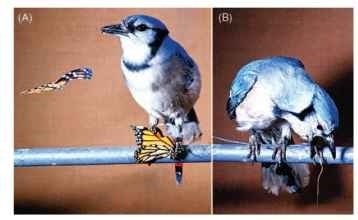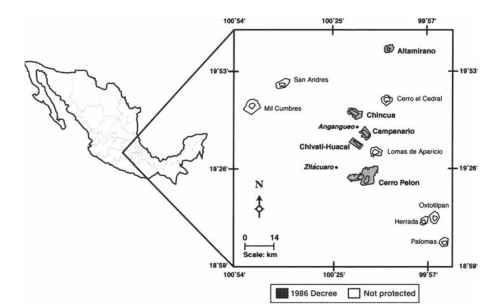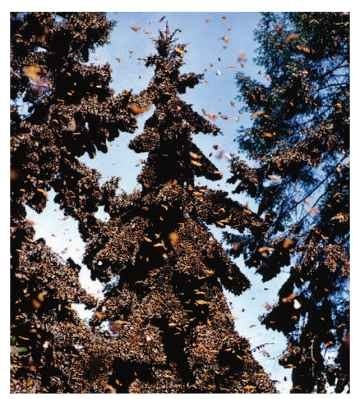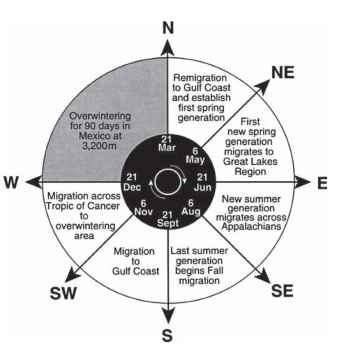The monarch butterfly (Danaus plexipypus, Nymphalidae) belongs to the tropical subfamily Danainae, the members of which are called milkweed butterflies because their larval host plants occur mainly in the milkweed family, Asclepiadaceae. With the exception of the monarch, most of the 157 known Danainae species are limited to tropical regions in Malaysia, Africa, South America, and the Greater Antilles. The adults of several species exhibit both short-distance migrations during the dry and wet seasons and social clustering behavior. This suggests that the long-distance migration and overwintering-aggregation behavior of the monarch butterfly in North America was evolutionarily elaborated from an ancient (ple-siomorphic) character of the taxon.
During the late Cenozoic, the milkweed genus Asclepias underwent an adaptive radiation that produced 108 species in temperate North America, ranging from Mexico to the boreal forests of Canada and from the Atlantic to the Pacific coasts. As the climate alternated between hot and cold periods during the Pleistocene, the North American flora periodically advanced and retreated. The author hypothesizes that the monarch tracked the geographic expansion and retraction of its milkweed hosts and in the process refined its inherited ancestral ability to move between habitats. Because the monarch cannot tolerate temperate zone winters, natural selection would have favored those individuals that moved southward as summer waned. As time passed, the migration syndrome gradually evolved to become increasingly sophisticated, ending in the present round-trip migration, one of the most complex in the animal kingdom (Fig. 1a and 1b ).
UNPALATABILITY AND MIMICRY
C. V Riley, the most famous 19th century entomologist in North America, proposed in 1871 that the monarch was distasteful and advertised its unpalatability with its conspicuous behavior and its spotted pattern of bright orange, black, and white. Time has proven him correct and a remarkable coevolutionary interaction of the monarch with the North American Asclepias species resulted in great refinements of the monarch’s chemical defense. Milkweeds synthesize differing arrays and amounts of vertebrate heart poisons, known as cardenolides. These are bitter-tasting chemicals that cause severe vomiting when ingested. Monarch larvae are insensitive to these molecules and, as they feed on the milkweeds, they sequester and store them in their bodies. The poisons are passed on into the chry-salids and then to the adults in sufficient amounts to sicken vertebrate predators, especially birds and mice. Laboratory experiments with blue jays (Cyanocitta cristata) have shown that some monarchs are so toxic that once a bird has eaten one, the noxious experience is so intense that the bird not only refuses monarchs in future encounters, but may actually retch at the sight of another (Fig. 2a and 2b).
Riley also proposed that the unrelated viceroy butterfly (Limenitis archippus) had evolved through natural selection to mimic the color pattern of the monarch. The viceroy was originally considered palatable and a so-called Batesian mimic, but recent studies suggest that it is also unpalatable. Therefore the monarch and viceroy have most likely converged on a common warning color pattern and are Mullerian mimics. However, the situation is more complex because some milkweeds lack cardenolides. As a result, monarch larvae that feed on nontoxic milkweeds produce palatable butterflies, whereas those that feed on toxic species produce unpalatables. This discovery gave rise to the concept of automimicry, in which palatable members of a species are identical in appearance to, but are protected by their exact resemblance to, the unpalatable ones. Thus in the wild, mon-archs exhibit a “palatability spectrum,” with the result that mixed populations of monarchs and viceroys may simultaneously exhibit Batesian mimicry, Mullerian mimicry, and automimicry.
THE EASTERN AND WESTERN MIGRATORY POPULATIONS
Monarchs that breed west of the Rocky Mountains have been known since the mid-19th century to migrate during the fall from their breeding areas to numerous overwintering sites along the coast of California, the most famous of which is in Pacific Grove on the Monterey Peninsula. Almost certainly attracted to each other by visual and pheromone signals, the butterflies aggregate from mid-October through February in spectacularly dense clusters on the live branches of Monterey pines, cypress, and eucalyptus. As spring advances, the surviving monarchs mate and migrate inland, where the females seek out the spring flush of milkweeds on which they lay singly up to 400 eggs before they die.
It was long suspected that the much larger eastern population of monarchs—those that breed during the summer in a 2.6 million km2 area east of the Rocky Mountains—migrates to Mexico. Fred and Norah Urquhart at the University of Toronto developed a wing-tagging program involving hundreds of collaborating amateurs that
![(A) Two migratory populations of the monarch butterfly occur in North America. The western population breeds west of the Rocky Mountains during the spring and summer and migrates to numerous overwintering sites, mainly along the California coast. The second, much larger eastern population breeds over several generations east of the Rocky Mountains and in the autumn migrates southward to overwintering sites in the high peaks of the Transverse Neovolcanic Belt, south of the Tropic of Cancer in central Mexico. Migration across the Gulf of Mexico and through Florida and to Guatemala remains hypothetical. [Reproduced from Brower (1995), with permission of the Lepidopterists' Society.] (B) Spring remigrations of the monarch butterfly in North America. Western monarchs leave the coastal overwintering areas in early spring and reestablish their summer breeding range as shown. Monarchs that overwintered in Mexico remigrate at the end of March to the Gulf Coast states, where they oviposit on southern milkweeds (Asclepias) and produce the first new spring generation of adults by the end of April to early May. These butterflies migrate northeasterly across the midwestern states to southern Canada, laying eggs along the way and establishing a large second generation in the western and central Great Lakes region. The midwestern component of the second-generation monarchs is produced in June and they appear to continue the migration eastward over the Appalachians. One or two more summer generations (depending on temperature) follow in the Midwest and east of the Appalachians, with the last generation entering reproductive diapause and migrating southward in the autumn. Spring remigrations over the Gulf of Mexico and through Cuba and Florida remain hypothetical. (A) Two migratory populations of the monarch butterfly occur in North America. The western population breeds west of the Rocky Mountains during the spring and summer and migrates to numerous overwintering sites, mainly along the California coast. The second, much larger eastern population breeds over several generations east of the Rocky Mountains and in the autumn migrates southward to overwintering sites in the high peaks of the Transverse Neovolcanic Belt, south of the Tropic of Cancer in central Mexico. Migration across the Gulf of Mexico and through Florida and to Guatemala remains hypothetical. [Reproduced from Brower (1995), with permission of the Lepidopterists' Society.] (B) Spring remigrations of the monarch butterfly in North America. Western monarchs leave the coastal overwintering areas in early spring and reestablish their summer breeding range as shown. Monarchs that overwintered in Mexico remigrate at the end of March to the Gulf Coast states, where they oviposit on southern milkweeds (Asclepias) and produce the first new spring generation of adults by the end of April to early May. These butterflies migrate northeasterly across the midwestern states to southern Canada, laying eggs along the way and establishing a large second generation in the western and central Great Lakes region. The midwestern component of the second-generation monarchs is produced in June and they appear to continue the migration eastward over the Appalachians. One or two more summer generations (depending on temperature) follow in the Midwest and east of the Appalachians, with the last generation entering reproductive diapause and migrating southward in the autumn. Spring remigrations over the Gulf of Mexico and through Cuba and Florida remain hypothetical.](http://lh6.ggpht.com/_X6JnoL0U4BY/S8HaScnrZQI/AAAAAAAAYTk/O1TVXfy0Q1o/tmp6424_thumb_thumb.jpg?imgmax=800)
FIGURE 1 (A) Two migratory populations of the monarch butterfly occur in North America. The western population breeds west of the Rocky Mountains during the spring and summer and migrates to numerous overwintering sites, mainly along the California coast. The second, much larger eastern population breeds over several generations east of the Rocky Mountains and in the autumn migrates southward to overwintering sites in the high peaks of the Transverse Neovolcanic Belt, south of the Tropic of Cancer in central Mexico. Migration across the Gulf of Mexico and through Florida and to Guatemala remains hypothetical. [Reproduced from Brower (1995), with permission of the Lepidopterists' Society.] (B) Spring remigrations of the monarch butterfly in North America. Western monarchs leave the coastal overwintering areas in early spring and reestablish their summer breeding range as shown. Monarchs that overwintered in Mexico remigrate at the end of March to the Gulf Coast states, where they oviposit on southern milkweeds (Asclepias) and produce the first new spring generation of adults by the end of April to early May. These butterflies migrate northeasterly across the midwestern states to southern Canada, laying eggs along the way and establishing a large second generation in the western and central Great Lakes region. The midwestern component of the second-generation monarchs is produced in June and they appear to continue the migration eastward over the Appalachians. One or two more summer generations (depending on temperature) follow in the Midwest and east of the Appalachians, with the last generation entering reproductive diapause and migrating southward in the autumn. Spring remigrations over the Gulf of Mexico and through Cuba and Florida remain hypothetical.

FIGURE 2 (A) A blue jay eats a monarch butterfly that contains the emetic heart poisons that its larva had sequestered from a milkweed plant. (B) About 15 min later, the jay sickens and vomits. One unpleasant experience is sufficient for most jays to avoid all further monarchs on sight.
finally led one of their associates, Kenneth Brugger, to discover the first overwintering site in Mexico on January 2, 1975. Subsequent searching by Lincoln Brower, William Calvert, and their Mexican colleagues located overwintering sites on 12 separate mountain ranges within a 30 X 60 km area of central Mexico (Fig. 3). Unlike the coastal overwintering sites in California, the overwintering areas in Mexico all occur above 3200 m altitude in a coniferous oyamel fir-pine ecosystem. This is a very limited ecosystem in the Transverse Neovolcanic Belt of mountains that run across Mexico, just south of the Tropic of Cancer.
THE MEXICO OVERWINTERING PHENOMENON
The numbers of butterflies in the Mexican overwintering colonies are astoundingly large (Fig. 4). Early research, based on mark, release, and recapture studies in California, suggested that the butterfly densities in Mexico are 10 times greater and led to an estimate of 10 million monarchs per hectare (2.47 acres) of forest. However, a catastrophic winter storm in January 2002 killed so many butterflies

FIGURE 3 Locations of 12 mountain massifs on which monarch butterfly overwintering occurs in the oyamel-pine forest ecosystem of central Mexico, about 120 km west of Mexico City. The total area shown is approximately 11,700 km2. The five shaded polygons are overwintering areas protected by presidential decree in 1986 (16,100ha). The unshaded polygons are seven additional overwintering areas that currently are not protected.

FIGURE 4 Monarch butterflies festooning oyamel trees in the Sierra Chincua on a clear day, 1991. (Photograph by L. P. Brower.)
(one sample had more than 50,000 dead butterflies in a single square meter!) that the revised density estimate is now at least five times this. In other words, the fir and pine trees are festooned with 50 million monarchs per hectare. So far the maximum combined area occupied by all known colonies is about 20 ha, a total of at least 1 billion mon-archs. The extraordinary beauty and mystery of the densely aggregated cluster of monarchs in these colonies is now well known. They represent one of the greatest biological wonders on this planet.
The extreme unpalatability of monarchs was probably one factor that allowed the species to elaborate the extremely dense winter aggregation behavior. Were they not chemically protected, the aggregations— an enormous potential food supply—would be exploited by vertebrate predators. In fact, field studies have shown that most, but not all, species of birds and mice in the overwintering areas in both California and Mexico avoid eating monarchs. However, in Mexico, orioles and grosbeaks have broken through the chemical protection and killed an average of 15,000 monarchs per day in one colony, that is, more than a million butterflies during the overwintering season. Again, the old adage holds that no protection, no matter how sophisticated, can ever be perfect.
THE MULTIGENERATIONAL MIGRATION SYNDROME
Because various milkweed species fed upon by monarch larvae synthesize arrays of chemically distinct cardenolides, it is possible to extract the molecules from the butterflies and by thin-layer chromatography to obtain a chemical fingerprint that indicates which species of milkweed each monarch ate when it was a caterpillar. Using this technique, Brower and his colleagues determined that individual monarchs that have survived the winter in Mexico remigrate in the spring to the Gulf coastal states where they lay their eggs and then die. The ensuing new spring generation then continues the migration northward into the Great Lakes region and establishes the first summer generation.
By July, the first summer generation of monarchs disperses east to the Atlantic coast and west to the Rocky Mountains and produces at least one more generation of adults. By mid-August, shortening daylength and colder nights reduce juvenile hormone production in the final summer generation. This prevents gonadal maturation and the butterflies become gregarious and begin their fall migration to Mexico. As shown by Gibo, these migrants are adept at using thermal lift and tail winds. As dusk approaches, the butterflies drift down and aggregate on trees where they spend the night. When the winds blow from the south, the butterflies interrupt their migration and seek out fields of flowers and assiduously drink nectar. They convert the sugar in the nectar into lipid and store it in their abdominal fat bodies. By the time the migrants reach central Texas, they have increased their lipid content by 500%. This reserve is crucial both to sustain them over their 5 months’ overwintering period and to fuel the subsequent 1 month’s spring remigration.
UNRESOLVED QUESTIONS
The individual monarchs of the last summer generation are genetically programmed to perform this migration to central Mexico in the fall, to survive the winter, and then to remigrate to the southern United States in the spring. Thus adult monarchs born in the Toronto area in August and returning to central Texas the following April traverse a distance of more than 5000 km. Their ability to find their way through deserts and mountain passes, to compensate for wind drift, and finally to locate the very small areas in Mexico that they have never before encountered remains a mystery. It will probably be solved when satellites can monitor electronic tags placed on individual butterflies.
The migratory orientation of individual monarchs shifts from south in the fall to north in the spring. How they maintain a particular course is poorly understood. While recent evidence casts doubt on the possibility that they may use magnetic orientation, there is strong evidence that sun compass orientation is involved. A complementary hypothesis is that monarch individuals have an internal clock that ticks away in all life stages and shifts the potential angle of the migration direction 1° per day throughout the year. Thus, at the spring equinox, the monarchs head out of their Mexican overwintering areas on a due north course (0°). The new spring generation, about 45 days later, heads northeastward toward the Great Lakes (45° ), and the next generation that is produced about 90 days after the spring equinox heads due east (90°). By the fall equinox (September 21), their heading would be 180°, that is, due south, changing to southwesterly as they migrate southward and finally reach the overwintering areas in November and December (Fig. 5 ).
Another unresolved question is the degree to which the eastern and western North American migratory populations are geographically isolated from each other. Molecular evidence suggests little differentiation, and it is possible that the western population is derived from and ultimately dependent on monarchs that get displaced westward by occasional strong northwesterly winds during the spring remigration from Mexico. Until the natural interchange between the eastern and the western populations is better understood, it seems prudent to avoid experimental and frivolous commercial transfers between them.
MIGRATION AND OVERWINTERING: ENDANGERED BIOLOGICAL PHENOMENA
The overwintering monarchs in Mexico are highly adapted to the oyamel fir-pine forest ecosystem. The forest provides a microclimatic envelope that protects the butterflies during the five winter months and allows them to remain in reproductive dormancy until the northern milkweed flora resurges in the spring. The high altitude

FIGURE 5 The rotational orientation hypothesis holds that all generations of monarch butterflies are migratory and that their orientation shifts clockwise at a rate of 1° per day throughout the year. The number of generations produced in each annual cycle varies from three to five and is temperature dependent. The spring equinox apparently triggers the northward remigration from Mexico. As time proceeds, the hypothesis holds that the orientation of subsequent generations shifts as shown, with some degree of scattering in each successive geographic displacement. Once the last generation has reached the overwintering sites, their migratory activity is repressed, but their orientation clock is assumed to continue running. By the time the cycle is complete at the new spring equinox, the overwintered butterflies are primed to migrate due north.
and low latitude selected by the butterflies combine to provide a microclimate beneath the forest canopy that is generally wet enough to prevent the butterflies from desiccating, warm enough to prevent their freezing, and cool enough to preserve their lipid reserves. However, their overwintering can be precarious.
Anderson and Brower determined that adult monarchs can tolerate temperatures to about -8°C if they are dry, but when wetted by rain and exposed to the night sky they lose most of their natural freezing resistance. They concluded that an intact forest serves both as a blanket and as an umbrella for the overwintering monarchs and that removal of even a single large tree exposes and jeopardizes thousands of monarchs during winter storms. Unfortunately this warning was realized in January 2002 when a severe northern cold front penetrated the overwintering region. The ensuing storm soaked and then froze more than a quarter of a billion butterflies in the Chincua and Campanario colonies. The severity of this kill was exacerbated by the fact that the surrounding forests have been thinned and severely fragmented, and despite three presidential decrees supposedly protecting the overwintering forests, extensive legal and illegal logging is accelerating throughout the region.
Monarchs are also becoming rapidly imperiled in their eastern breeding range by industrialized agriculture that is eliminating milkweeds and nectar sources. An assay based on hydrogen and carbon isotope ratios that vary systematically with respect to the geographic origin of the monarch’s Asclepias syriaca food plants has determined that the major area of summer breeding in the United States coincides with the corn belt that has replaced the former grassland ecosystem in the midwestern United States. This has ominous implications because of the genetic engineering of crops to be resistant to herbicides. Massive and increasingly sophisticated herbicide spraying is killing the principal milkweed food plant of the monarch (A. syriaca- as well as most of the native flora over tens of thousands of hectares. Thus monarchs are losing both their larval food resources and their access to the diversity of flowers that provide critical nectar resources.
Because of these combined pressures on the breeding, migratory, and overwintering habitats, the migration of the monarch butterfly in North America has become an endangered biological phenomenon. The remarkable syndrome manifested by the monarch butterfly is too great a cultural and scientific treasure to allow these rampantly destructive processes to continue. Time is rapidly running out.
